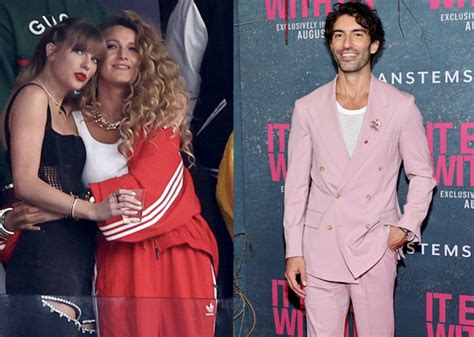
Amidst anticipation for the film adaptation of Colleen Hoover’s bestselling novel “It Ends With Us,” recent revelations from Justin Baldoni’s body double have shed light on a potentially strained atmosphere on set, with the stand-in describing the vibe as “tense” during filming with Blake Lively.
The production of “It Ends With Us,” starring Blake Lively as Lily Bloom and Justin Baldoni as Ryle Kincaid, has been marked by both excitement and controversy. The adaptation of Hoover’s popular novel has been eagerly awaited by fans, but recent remarks from a body double suggest underlying tensions may have permeated the filming process. The body double, who worked closely with Justin Baldoni, described the on-set atmosphere as noticeably “tense,” raising questions about the dynamics between cast and crew during the making of the film. This revelation provides a behind-the-scenes glimpse into a production that has already faced scrutiny and high expectations from its dedicated fanbase.
According to the body double, the tension was palpable, although specific details regarding the cause of the strained atmosphere remain undisclosed. “The vibe was very tense on set,” the body double stated. While the body double didn’t provide explicit reasons for the tension, their comments hint at potential challenges faced during the film’s production. This sentiment adds another layer to the narrative surrounding “It Ends With Us,” which has already navigated casting controversies and concerns about accurately portraying the novel’s complex themes.
The “It Ends With Us” movie, based on Colleen Hoover’s bestselling novel, has been under intense scrutiny since its announcement. The casting of Blake Lively as Lily Bloom, a character significantly younger in the book, ignited a wave of debate among fans. Similarly, Justin Baldoni’s dual role as both actor and director has raised questions about his capacity to manage both responsibilities effectively. The recent remarks from the body double only add to the existing narrative, suggesting that the on-set atmosphere may have been affected by these and other pressures.
One potential source of tension could stem from the pressure to deliver a faithful adaptation while making necessary changes for the screen. The novel deals with sensitive topics such as domestic violence and toxic relationships, requiring a delicate approach to ensure the film treats these themes responsibly. Adapting such material often involves navigating creative differences and logistical challenges, which can sometimes lead to friction among those involved.
The production team has remained largely silent on the body double’s comments, leaving fans to speculate about the reasons behind the described “tense” atmosphere. However, these comments serve as a reminder of the complexities involved in bringing a beloved book to the big screen. The pressure to meet fan expectations, combined with the inherent challenges of filmmaking, can create a high-stress environment for everyone involved.
The success of “It Ends With Us” will depend not only on its ability to capture the essence of Hoover’s novel but also on the cast and crew’s ability to navigate the challenges and tensions that arise during production. As the release date approaches, audiences and industry insiders will be closely watching to see if the film can overcome these obstacles and deliver a compelling and meaningful adaptation.
Colleen Hoover’s “It Ends With Us” has garnered immense popularity for its exploration of complex relationships and sensitive themes. The novel tells the story of Lily Bloom, a young woman who moves to Boston and starts a relationship with Ryle Kincaid, a charming but troubled neurosurgeon. As their relationship progresses, Lily is forced to confront her past and make difficult decisions about her future. The novel’s raw and emotional portrayal of love, abuse, and resilience has resonated with readers worldwide, making it a New York Times bestseller and a social media phenomenon.
The decision to adapt “It Ends With Us” into a film was met with both excitement and apprehension. Fans were eager to see their favorite characters brought to life on the big screen, but they also expressed concerns about whether the film could accurately and sensitively portray the novel’s complex themes. The casting choices, particularly Blake Lively as Lily Bloom, sparked debate due to the age difference between the actress and the character as described in the book.
Justin Baldoni, known for his role in “Jane the Virgin,” was cast as Ryle Kincaid and also took on the role of director. Baldoni’s involvement in the project raised questions about his ability to balance both responsibilities effectively. Directing a film while also playing a lead role can be a demanding task, requiring exceptional time management and focus. Furthermore, Baldoni’s previous work has primarily been in television, making “It Ends With Us” a significant undertaking for him as a director.
The challenges of adapting “It Ends With Us” extend beyond casting and directing. The novel deals with sensitive issues such as domestic violence and toxic relationships, requiring a delicate and nuanced approach. The filmmakers must ensure that these themes are portrayed responsibly and accurately, without sensationalizing or trivializing them. This requires careful consideration of the script, the performances, and the overall tone of the film.
The recent comments from the body double regarding the “tense” atmosphere on set add another layer of complexity to the “It Ends With Us” narrative. While the specific reasons for the tension remain unclear, the remarks suggest that the production may have faced challenges beyond the typical difficulties of filmmaking. The pressure to meet fan expectations, combined with the sensitive nature of the source material, could have contributed to a high-stress environment for the cast and crew.
As the film progresses through post-production, the filmmakers face the task of shaping the raw footage into a cohesive and compelling story. The editing process will be crucial in determining how the film’s themes are presented and how the characters are portrayed. The filmmakers must strike a balance between staying true to the novel and making necessary changes for the screen. The success of “It Ends With Us” will depend on their ability to navigate these challenges and deliver a film that resonates with audiences while honoring the spirit of Colleen Hoover’s beloved novel.
The comments from the body double working on the “It Ends With Us” movie set have ignited discussions about the potential stressors involved in adapting popular novels into films. Film sets are often high-pressure environments, and the adaptation of a beloved book can amplify these pressures significantly. The weight of fan expectations, the need to stay true to the source material, and the challenges of translating complex narratives to the screen can create a tense atmosphere for everyone involved.
The casting choices for “It Ends With Us” have already been a subject of debate. Blake Lively, while a talented actress, does not align perfectly with the age and physical description of Lily Bloom in the novel. This casting decision has led to criticism from some fans who feel that it deviates too far from the source material. Justin Baldoni’s casting as Ryle Kincaid has also been met with mixed reactions, with some questioning whether he is the right fit for the character.
The dual role of Justin Baldoni as both actor and director adds another layer of complexity to the production. Directing a film is a demanding task that requires significant time and attention. Simultaneously playing a lead role can further stretch an individual’s resources, potentially leading to increased stress and tension. It is possible that Baldoni’s dual role contributed to the “tense” atmosphere described by the body double.
Adapting a novel like “It Ends With Us,” which deals with sensitive themes such as domestic violence, requires a delicate and nuanced approach. The filmmakers must be mindful of how these themes are portrayed and ensure that they are treated with respect and sensitivity. This can involve navigating complex ethical considerations and making difficult decisions about what to include and exclude from the film. The process of adapting such material can be emotionally taxing for everyone involved.
The pressure to deliver a successful adaptation can also contribute to tension on set. The filmmakers are aware that they are working with a beloved property and that fans have high expectations. This awareness can create a sense of pressure to get things right, which can lead to increased stress and anxiety. The financial stakes are also high, as a successful adaptation can generate significant revenue for the studio. This financial pressure can further amplify the tension on set.
The comments from the body double serve as a reminder of the human element involved in filmmaking. While the finished product may appear seamless and polished, the process of creating a film is often fraught with challenges and difficulties. The cast and crew are under immense pressure to deliver a high-quality product, and this pressure can take a toll on their well-being. The “tense” atmosphere described by the body double highlights the importance of creating a supportive and collaborative environment on set, where everyone feels valued and respected.
The adaptation of “It Ends With Us” into a film is a complex undertaking that involves navigating numerous challenges and pressures. The casting choices, the dual role of Justin Baldoni, the sensitive themes of the novel, and the high expectations of fans all contribute to the potential for tension on set. The comments from the body double serve as a valuable reminder of the human element involved in filmmaking and the importance of creating a supportive and collaborative environment. As the film progresses through post-production, it remains to be seen whether the filmmakers can overcome these challenges and deliver a successful adaptation that resonates with audiences.
The revelation of a “tense” set environment during the filming of “It Ends With Us” brings to light the multifaceted pressures inherent in adapting popular literature for the screen. Such adaptations are often subjected to intense scrutiny, not only from the original book’s dedicated fanbase but also from critics and industry observers. The transition from page to screen involves a delicate balancing act, requiring filmmakers to remain faithful to the source material while also making necessary adjustments for the cinematic medium.
The weight of expectation from fans can be particularly burdensome. Readers often have strong emotional connections to the characters and storylines in their favorite books, and they may have specific ideas about how these elements should be portrayed in a film adaptation. Any deviation from these expectations can lead to disappointment and criticism, creating a sense of pressure for the filmmakers to deliver a product that satisfies the demands of a diverse and passionate audience.
The casting process is often a source of contention, as fans may have differing opinions about which actors are best suited to portray the beloved characters. In the case of “It Ends With Us,” the casting of Blake Lively as Lily Bloom has already sparked debate due to the age difference between the actress and the character as described in the novel. Such casting decisions can create a divide within the fanbase, with some viewers accepting the choice while others remain skeptical.
The dual role of Justin Baldoni as both actor and director adds another layer of complexity to the production. While it is not uncommon for actors to also direct films, it can be a challenging undertaking that requires exceptional time management and focus. Balancing the responsibilities of both roles can be physically and mentally demanding, potentially leading to increased stress and tension on set.
The adaptation of “It Ends With Us” also involves navigating sensitive themes such as domestic violence and toxic relationships. These themes require a delicate and nuanced approach to ensure that they are portrayed responsibly and accurately. The filmmakers must be mindful of the potential impact of these themes on viewers and avoid sensationalizing or trivializing them. This requires careful consideration of the script, the performances, and the overall tone of the film.
The financial stakes involved in adapting a popular novel can also contribute to tension on set. Film studios invest significant resources in these projects, and they expect a return on their investment. This financial pressure can create a sense of urgency and anxiety, as the filmmakers strive to deliver a product that is both artistically successful and commercially viable.
The comments from the body double regarding the “tense” atmosphere on set provide a glimpse into the human element involved in filmmaking. While the finished product may appear polished and seamless, the process of creating a film is often fraught with challenges and difficulties. The cast and crew are under immense pressure to deliver a high-quality product, and this pressure can take a toll on their well-being.
The “It Ends With Us” film project is a high-profile undertaking with significant expectations from fans and industry observers. The comments from the body double add an intriguing dimension to the narrative, highlighting the potential stressors involved in adapting a beloved novel for the big screen. As the film nears completion, audiences will be keenly observing whether the filmmakers have successfully navigated these challenges and delivered a compelling and meaningful adaptation.
The challenges of adapting “It Ends With Us” are multifaceted, reflecting the complexities of both the source material and the filmmaking process itself. Colleen Hoover’s novel delves into sensitive and emotionally charged themes, requiring careful consideration and nuanced execution in any adaptation.
The film faces the hurdle of capturing the essence of Hoover’s writing style, which is characterized by its raw honesty and emotional depth. Translating this style to the screen requires a delicate balance between dialogue, visuals, and performance, ensuring that the film resonates with the same emotional impact as the book.
The character of Lily Bloom is central to the story, and the casting of Blake Lively has been a subject of much discussion. While Lively is a talented actress, some fans have questioned whether she is the right fit for the role, given the age difference between her and the character in the novel. The film must overcome these concerns by showcasing Lively’s ability to embody the complexities and vulnerabilities of Lily Bloom.
Ryle Kincaid is another key character, and Justin Baldoni’s dual role as both actor and director adds an interesting dynamic to the production. Baldoni’s understanding of the character may provide valuable insight, but he also faces the challenge of balancing his responsibilities as both performer and director.
The film must also address the sensitive topic of domestic violence with care and respect. This requires a thoughtful approach to the depiction of abusive behavior, avoiding sensationalism while accurately portraying the emotional and physical impact on the victim. The filmmakers must work closely with experts and advocates to ensure that the film handles this topic responsibly.
The adaptation of “It Ends With Us” also involves making necessary changes to the story to fit the cinematic format. This may include condensing certain plot points, streamlining the narrative, or altering the sequence of events. These changes must be made carefully to avoid sacrificing the core themes and emotional resonance of the novel.
The “tense” atmosphere described by the body double raises questions about the challenges of managing the creative process and maintaining a positive working environment on set. Filmmaking is a collaborative endeavor, and conflicts and disagreements are inevitable. However, it is important to address these issues constructively to avoid creating a toxic or stressful atmosphere.
The success of “It Ends With Us” as a film adaptation will depend on the ability of the filmmakers to navigate these challenges and deliver a product that is both faithful to the source material and compelling as a cinematic experience. The film has the potential to reach a wide audience and spark important conversations about love, abuse, and resilience. However, it is crucial that the filmmakers approach the project with sensitivity, respect, and a commitment to quality.
Frequently Asked Questions (FAQ)
1. What is “It Ends With Us” about?
“It Ends With Us” is a novel by Colleen Hoover that tells the story of Lily Bloom, a young woman who moves to Boston and starts a relationship with Ryle Kincaid, a charming neurosurgeon. As their relationship progresses, Lily is forced to confront her past and make difficult decisions about her future. The novel explores themes of love, abuse, and resilience.
2. Who are the main actors in the “It Ends With Us” movie adaptation?
Blake Lively stars as Lily Bloom, and Justin Baldoni plays Ryle Kincaid. Baldoni is also the director of the film.
3. Why has the casting of Blake Lively as Lily Bloom been controversial?
Some fans have criticized the casting of Blake Lively because of the age difference between the actress and the character of Lily Bloom as described in the novel. Lively is older than the character is portrayed in the book.
4. What does it mean when the body double says that the vibe was “tense” on set?
The phrase “tense” suggests that there may have been stress, conflict, or unease among the cast and crew during the filming process. It implies that the atmosphere was not relaxed or harmonious, potentially due to creative differences, logistical challenges, or other pressures associated with filmmaking.
5. What are some of the challenges of adapting “It Ends With Us” into a film?
Adapting “It Ends With Us” presents several challenges, including staying true to the novel’s complex themes, portraying sensitive issues such as domestic violence responsibly, managing fan expectations, and balancing the roles of actor and director (in Justin Baldoni’s case). Additionally, translating the author’s writing style to the screen and ensuring the film resonates emotionally with viewers are crucial aspects of the adaptation process.









